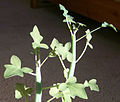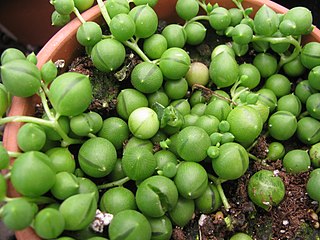
Curio rowleyanus, syn. Senecio rowleyanus, is a flowering plant in the daisy family Asteraceae. It is a creeping, perennial, succulent vine native to the drier parts of southwest Africa. In its natural environment its stems trail on the ground, rooting where they touch and forming dense mats. It often avoids direct sunlight by growing in the shade of other plants and rocks. It is commonly known as string-of-pearls or string-of-beads.

Plumbago auriculata, the cape leadwort, blue plumbago or Cape plumbago, is a species of flowering plant in the family Plumbaginaceae, native to South Africa.

Farfugium japonicum is a species of flowering plant in the family Asteraceae, also known as leopard plant, green leopard plant or tractor seat plant. It is native to streams and seashores of Japan, where it is called tsuwabuki (石蕗).

Senecio angulatus, also known as creeping groundsel and sometimes as Cape ivy, is a succulent plant from the family Asteraceae of the genus Senecio that is native to South Africa. It is a scrambling and a twining herb that can become an aggressive weed once established, making it an invasive species in some countries. However, it is grown as an ornamental plant for its satiny foliage and sweet-scented flowers.

Senecio tamoides, also known as Canary creeper, is a climbing member of the genus Senecio of the family Asteraceae that is native to Southern Africa. It is used as an ornamental plant for its showy yellow, daisy-like flowers in autumn.
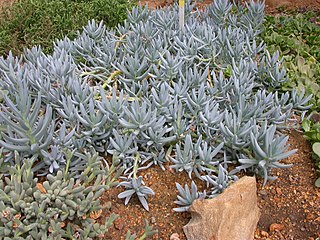
Curio repens, syn. Senecio serpens, is a species of the genus Curio in the Asteraceae family. A succulent endemic to the Western Cape province of South Africa, it is typically found growing from crevices in rocky sandstone slopes. Commonly named blue chalksticks, it is used as an ornamental plant.

Jatropha cathartica is a species of flowering plant in the spurge family, Euphorbiaceae, that is native to Texas in the United States and Coahuila, Nuevo León and Tamaulipas in northeastern Mexico. Common names include jicamilla (Spanish) and Berlandier's nettlespurge.
× Heucherella is an evergreen perennial flowering plant in the family Saxifragaceae. A hybrid of garden origin, it is the result of a cross between two distinct genera, Heuchera and Tiarella, and shows similarities to both parents. This type of intergeneric hybrid is quite rare, and is indicated by a multiplication symbol before the name. The name Heucherella is an example of a portmanteau word, a combination of the two parents' names.
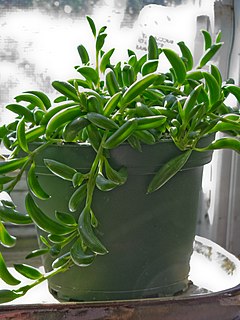
Curio radicans, syn. Senecio radicans, is a succulent houseplant that is native to South Africa. A member of the family Asteraceae, the asters, this species is closely related to the common String of Pearls and Curio hallianus. It has multiple tendrils of glossy, banana-shaped foliage. It is commonly known as string of bananas.

Crassula capitella, is a perennial succulent plant native to southern Africa.

Crassula ovata, commonly known as jade plant, lucky plant, money plant or money tree, is a succulent plant with small pink or white flowers that is native to the KwaZulu-Natal and Eastern Cape provinces of South Africa, and Mozambique; it is common as a houseplant worldwide. Much of its popularity stems from the low levels of care needed; the jade plant requires little water and can survive in most indoor conditions. It is sometimes referred to as the money tree; however, Pachira aquatica also has this nickname.

Gasteria baylissiana, Suurberg gasteria, is a species of succulent flowering plant in the family Asphodelaceae, native to the Eastern Cape, South Africa.

Plectranthus oertendahlii is a species of flowering plant in the sage and mint family, Lamiaceae. Common names include silverleaf spurflower, Swedish ivy, Oertendahl's spurflower, November lights, and Brazilian coleus though it is native to eastern South Africa rather than Brazil. Plectranthus oertendahlii and the cultivar ‘Uvongo’ have gained the Royal Horticultural Society’s Award of Garden Merit.
Eucomis schijffii is a bulbous species of flowering plant in the family Asparagaceae, subfamily Scilloideae, native to the Cape Provinces, KwaZulu-Natal and Lesotho. It was first described by William Frederick Reyneke in 1976. The reddish purple flowers appear in summer and are arranged in a spike (raceme), topped by a "head" of green leaflike bracts. It is cultivated as an ornamental plant and can be grown successfully outside where frosts are not too severe. The smallest of the species of Eucomis, it is particularly suited to being grown in rock gardens or containers.
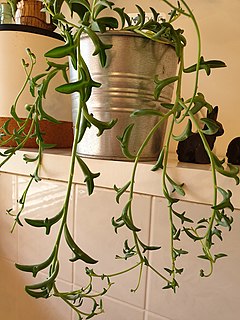
Curio × peregrinus, also known as dolphin necklace, flying dolphins, string of dolphins, dolphin plant or Senecio hippogriff, is a succulent nothospecies of Curio in the family Asteraceae. It is often called, incorrectly, Senecio peregrinus, but that name was previously given, by Grisebach in 1879, to a different species from South America. The name Curio × peregrinus was published in 1999, based on the earlier name Kleinia peregrina; however, this name was not validly published. The plant is a hybrid between Curio rowleyanus and Curio articulatus.

Curio herreanus, syn. Senecio herreanus, which is also known as string of watermelons, string of beads, gooseberry plant and string of raindrops, is a flowering succulent plant in the daisy family Asteraceae that is native to South Africa. It is grown as an ornamental plant and is very similar in appearance to 'string of pearls', where the names may be conflated.

Curio talinoides, syn. Senecio mandraliscae, also known as blue straws, blue chalksticks, dassieharpuis, or narrow-leaf chalk sticks, is a succulent plant of the sunflower family that is native to South Africa. The origin of this plant is dubious and it may be a hybrid.

Senecio candicans, commonly known as angel wings and sea cabbage, is a succulent flowering plant in the Senecio genus that is native to India and is grown as an ornamental plant elsewhere.

Curio 'Trident Blue', known commonly as Senecio 'Trident Blue', Trident Blue Chalk and Kleinia 'Trident Blue', is a spear-shaped succulent plant that is a hybrid of Curio repens and Curio talinoides.

Protea nana, also known as the mountain rose or mountain-rose sugarbush, is a flowering shrub which belongs within the genus Protea.



